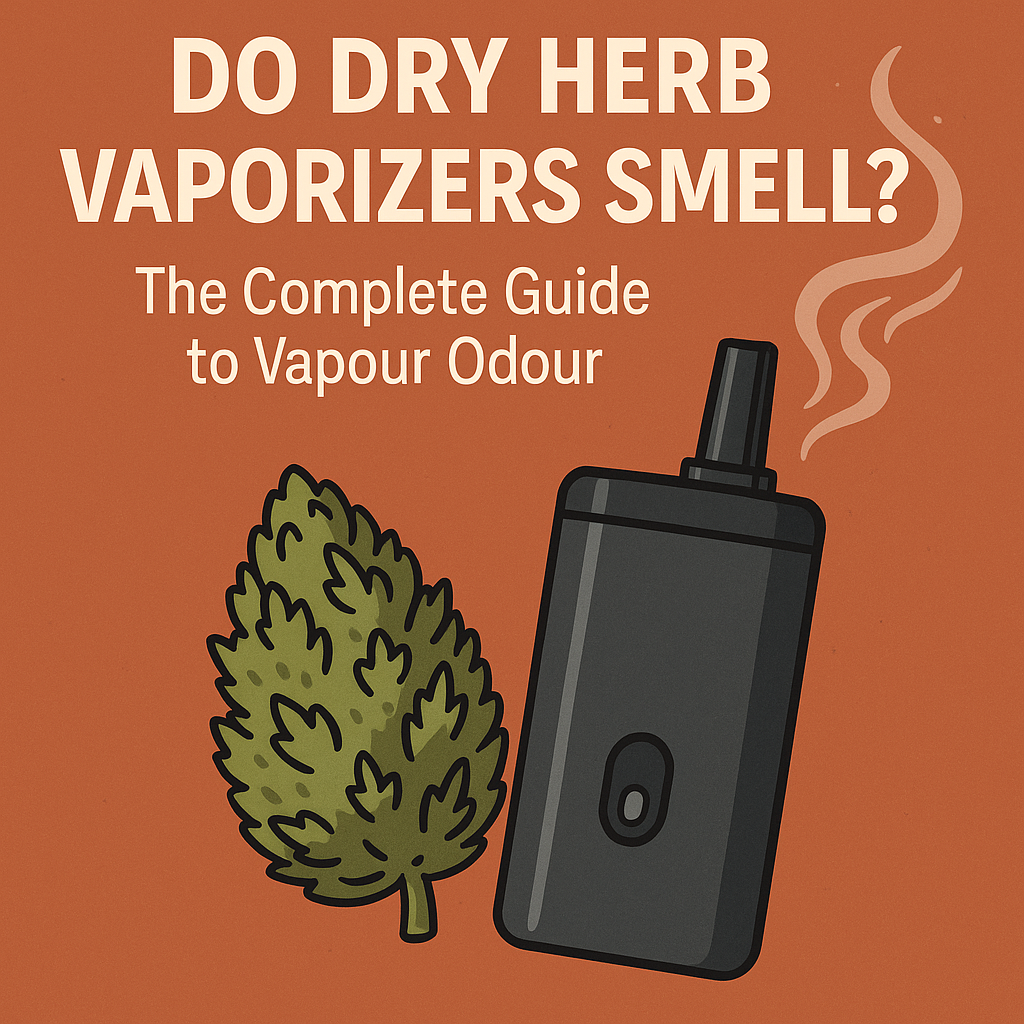If you're considering making the switch from smoking to vaporising dry herbs, one of the most common questions is about smell: Do dry herb vaporisers smell? The short answer is yes, they do produce an odour – but with some important differences from smoking that could make all the difference for your lifestyle and privacy needs.
The Science Behind Vaporiser Smell
Dry herb vaporisers work by heating plant material to temperatures that release the active compounds and terpenes (aromatic oils) without actually combusting the material. These released compounds and terpenes are what create the smell you notice during and after use.
When using a vaporiser, the odour produced is typically less intense and dissipates much faster compared to smoke. This is because combustion (smoking) creates many additional compounds through the burning process, many of which stick to surfaces and linger in the air for extended periods.
In contrast, vapour consists primarily of the essential oils and active compounds from the herb itself, without the additional byproducts of combustion. This results in a cleaner, more herb-forward aroma that doesn't cling to fabrics, hair, or furnishings nearly as much as smoke does.
How Much Do Vaporisers Actually Smell?
The reality is that vaporiser odour is significantly more manageable than most people expect. Here's what you can realistically expect:
Immediate Smell During Use
- Light to moderate aroma similar to the herbs themselves
- Localised smell that typically stays within 3-5 metres of use
- Fresh, plant-like scent rather than harsh smoke smell
- Varies with temperature - lower temps produce lighter odours
Lingering Odour After Use
- Dissipates within 15-45 minutes with basic ventilation
- Minimal residue on clothing or in hair
- No persistent room odour like cigarette smoke
- Fresh air circulation clears most traces quickly
This is a stark contrast to smoking, where odours can persist for hours or even days, penetrate fabrics, and travel throughout entire buildings.
Factors That Influence Vaporiser Smell Intensity
Several key factors determine how noticeable your vaporiser's odour will be:
1. Temperature Settings Make a Huge Difference
Lower Temperatures (160-185°C):
- Produce lighter vapour with subtle aromas
- Release mainly terpenes and lighter compounds
- Create minimal lingering smell
- Ideal for discreet use
Higher Temperatures (200°C+):
- Generate denser vapour with stronger odours
- Extract more compounds, creating fuller aromas
- Produce more noticeable immediate smell
- Better for home use with ventilation
Premium devices like the Arizer Solo 3 offer precise temperature control from 50°C to 220°C, allowing you to find the perfect balance between effects and discretion.
2. Heating Method Affects Odour Production
Conduction Heating:
- Creates more localised heating
- Often produces concentrated but brief odours
- Heat dissipates quickly when not in use
Convection Heating:
- Heats air passing through material
- Can create more efficient extraction
- May produce slightly more aromatic vapour initially
Hybrid Systems:
- Combine both methods for balanced extraction
- Often provide the most consistent odour levels
- Found in premium devices like the Mighty Plus
3. Session Style Impact on Smell
Session Vaporisers:
- Maintain temperature for 5-15 minutes
- Create steady vapour production throughout
- May produce more cumulative odour over time
On-Demand Vaporisers:
- Only heat when actively drawing
- Provide complete control over vapour production
- Allow for minimal odour sessions with quick hits
4. Device Design and Quality
Vapour Path Materials:
- Glass vapour paths (like in Arizer ArGo) tend to be more neutral
- Quality materials don't add artificial odours to your herbs
- Poor quality plastics can create unwanted smells
Sealed Systems:
- Well-designed devices contain odours when not in use
- Magnetic lids and proper seals make a difference
- Isolated airpaths prevent smell leakage
Real-World Odour Comparison: Vaping vs Smoking
Based on extensive user feedback and testing, here's how vaporiser odour compares to traditional smoking:
| Aspect | Vaporising | Smoking |
|---|---|---|
| Intensity | 50-70% less noticeable | Full combustion smell |
| Duration | 15-45 minutes with basic ventilation | 2-12 hours |
| Travel Distance | 3-5 metres from source | Throughout buildings |
| Clothing/Hair | Minimal, temporary | Heavy, persistent |
| Room Penetration | Surface level only | Deep into fabrics/walls |
| Outdoor Dissipation | Almost immediate | Several metres, long-lasting |
Environmental Factors That Affect Smell
Ventilation is Your Best Friend
- Open windows reduce odour by 70-80%
- Fan assistance can clear vapour in minutes
- Air circulation prevents smell accumulation
- Outdoor use virtually eliminates lingering odours
Room Size and Layout Matter
- Larger spaces dilute odours more effectively
- High ceilings allow vapour to disperse upward
- Multiple exits for air movement help significantly
- Enclosed spaces concentrate smells temporarily
Weather Conditions
- Humidity levels can affect how odours travel
- Air pressure changes influence smell dissipation
- Temperature differences affect vapour behaviour
- Wind outdoors disperses vapour immediately
Practical Strategies for Minimising Odour
Smart Device Selection
Choose vaporisers designed with discretion in mind. Some devices include specific features for odour management, such as stealth modes or ultra-efficient heating systems that minimise unnecessary vapour production.
Optimal Usage Techniques
- Start with lower temperatures and increase gradually
- Take controlled draws rather than continuous heating
- Use smaller amounts of material per session
- Time your sessions when ventilation is available
Environmental Management
- Create airflow with fans or open windows
- Use air purifiers with carbon filters if needed
- Choose appropriate locations like near windows or outdoors
- Consider timing when others aren't around
Post-Session Care
- Clean your device regularly to prevent odour buildup
- Store herbs in airtight containers
- Allow proper ventilation after use
- Wash hands to remove any residual smell
Different Vaporiser Types and Their Odour Profiles
Ultra-Portable Devices
Compact vaporisers typically produce less overall odour due to their smaller chambers and efficient heating systems. Their portability also makes it easier to use them in well-ventilated areas.
Desktop Vaporisers
Larger devices like the Volcano Hybrid may produce more immediate vapour but often include superior filtration systems and can be used with water filtration for enhanced odour control.
Session vs On-Demand
On-demand devices like the TinyMight V2 give you complete control over when vapour is produced, making them excellent for minimal-odour use.
Special Considerations for Different Settings
Home Use
- Most vaporisers are perfectly suitable for home use with basic ventilation
- Consider housemates' preferences and house rules
- Timing can be important in shared living situations
Travel and Accommodation
- Research local laws before travelling with any vaporiser
- Hotels may have policies about vapour as well as smoke
- Consider using devices with minimal odour production when away from home
Professional and Social Settings
- Even minimal odours may be inappropriate in some situations
- Consider the context and others' comfort levels
- Some environments may have zero-tolerance policies
The Bottom Line: Realistic Expectations
Yes, dry herb vaporisers do produce some odour – but it's dramatically less problematic than smoking. Here's what you can realistically expect:
What Vaporiser Odour Is Like:
- Plant-like and natural rather than harsh or acrid
- Temporary and manageable with basic precautions
- Localised to your immediate area during use
- Quick to dissipate with any air movement
What It's Not Like:
- Not like cigarette smoke that lingers for hours
- Not penetrating into fabrics and walls
- Not travelling throughout entire buildings
- Not leaving lasting traces on your person
Managing Expectations:
The smell is there, but it's more comparable to brewing herbal tea than smoking. With reasonable precautions – a window open, a fan on, or using the device outdoors – most people find vaporiser odour to be a non-issue in their daily lives.
Making the Switch: Is Smell Still a Concern?
For most people considering the switch from smoking to vaporising, odour concerns are significantly overblown. The reality is that modern vaporisers, when used sensibly, produce minimal and manageable odours that dissipate quickly.
If you're still concerned about discretion, consider:
- Starting with lower-temperature sessions to gauge odour levels
- Using the device outdoors initially to understand vapour production
- Testing during times when ventilation is optimal
- Choosing devices known for efficient, controlled extraction
The key is understanding that while vaporisers do produce some smell, it's a manageable aspect of a much cleaner, healthier consumption method. The dramatic reduction in odour intensity, duration, and persistence makes vaporising a viable option for most people who previously avoided herbal consumption due to smell concerns.
Ready to experience the difference for yourself? Browse our complete collection of premium dry herb vaporisers to find the perfect device for your discretion needs and lifestyle preferences.















Leave a comment
This site is protected by hCaptcha and the hCaptcha Privacy Policy and Terms of Service apply.